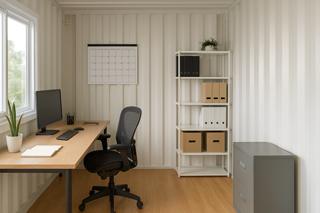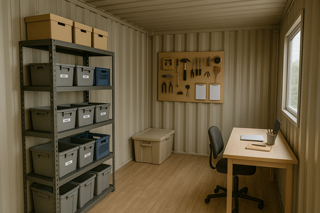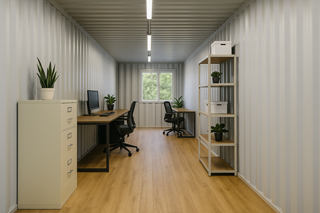A well-organized office can boost productivity, improve comfort, and make even the smallest workspaces feel functional. If you’re working from a modular or mobile office, you know the challenges of staying efficient in a compact area. That’s why organizing a shipping container office is essential for making the most of your limited space.
No matter where you place your container office, whether on a job site or as a permanent workspace, here are five practical tips to keep it streamlined and clutter-free.

1. Go Digital to Reduce Paper Clutter
Paper documents take up space quickly. By switching to digital files, you can reduce the need for bulky filing cabinets. For example, use cloud storage platforms like Google Drive or Dropbox to manage contracts, invoices, and plans.

However, if physical documents are unavoidable, try a small filing cabinet or wall-mounted organizer to keep papers tidy and accessible.
2. Use Multi-Purpose Furniture
When space is limited, every piece of furniture should do more than one job. Opt for desks with built-in drawers or storage benches that can double as seating. Additionally, consider foldable desks or collapsible tables that you can tuck away when not in use.
These choices support both comfort and space efficiency — a key element of small office space planning.
3. Label and Categorize Everything
One of the best ways to stay organized is to label storage bins, cabinets, and drawers. As a result, clearly marked storage helps everyone in the office know where things belong, saving time and reducing clutter.

For instance, use stackable bins or color-coded labels to quickly identify tools, paperwork, or supplies. You’ll be amazed how much smoother daily operations run with a clear system in place.
4. Use Vertical Space in Your Shipping Container Office
Above all, don’t let your walls go to waste. Vertical storage solutions are essential when organizing a shipping container office. Install shelves, pegboards, or magnetic strips to hold tools, binders, or office supplies.
Wall-mounted systems free up floor space and keep the items you use most within easy reach.
5. Manage Cables in a Small Office Space Effectively
Cables and devices can easily take over a small workspace. Use cord organizers, under-desk trays, and Velcro wraps to tame wires and keep things safe and tidy. Check out these cable management tools to keep cords organized and out of the way.

Mount monitors on the wall or use a dual-monitor arm to free up desk space and reduce visual clutter.
Final Thoughts
By applying these five tips, you can turn your shipping container office into a more productive, organized, and comfortable workspace. Ultimately, from going digital to using vertical space, every decision contributes to smarter small office space planning.
Still need help outfitting your container office? Contact Eagle Leasing today for expert solutions designed to meet your workspace needs.ll do our best to help you with all of your shipping container needs when you work with us at the Eagle Leasing Company.
Frequently Asked Questions
How do I organize a shipping container office efficiently?
Start by minimizing clutter using digital tools, then focus on space-saving furniture and vertical storage. Labeling and tidy cable management are also key steps when organizing a shipping container office.
What furniture works best in a small container office?
Multi-purpose furniture is ideal. Look for desks with built-in storage, foldable tables, and benches that double as drawers. These solutions are essential for small office space planning.
Are shipping container offices hard to organize?
Not at all. With the right strategy—like using vertical space and reducing paper—you can make your shipping container office both functional and efficient.
Can I add tech to a container office without cluttering it?
Yes. Wall-mount your monitor, hide cables using organizers, and group power strips strategically. Clean cable setups are important when planning small office spaces.









